Yves here. This finding about manufacturing skills should be no surprise, but it is useful to have confirmation. My father ran paper mills, and he always made sure to schedule his time so he would talk to workers on every shift each day. He understood that their know-how was critical.
By David Kunst, PhD candidate in Economics, Tinbergen Institute and Vrije Universiteit Amsterdam. Originally published at VoxEU
Has technological progress in manufacturing been skill-biased or deskilling? This column argues that the conventional distinction between white-collar and production workers has concealed substantial deskilling among manufacturing production workers since the 1950s. Automation has reduced the demand for skilled craftsmen around the world, thereby reducing the number of jobs in which workers with little formal education could acquire significant marketable skills.
Dating back to at least Tinbergen (1974), the literature on skill demand has argued that technological progress is skill-biased in the sense that it requires increasing human capital investment on the part of workers. The recent increase in inequality is then in part viewed as a consequence of increasing returns to skill. In contrast, Braverman (1974) asserts in an influential book from the same year that “the capitalist mode of production systematically destroys all-around skills where they exist”.1
A closer look reveals that both statements may be correct. While the modern literature documents an increasing demand for skilled non-production, or ‘white-collar’, workers in manufacturing (Berman et al. 1994, 1998), Braverman’s claim is about deskilling within the large group of production workers. If he is right, the narrative of technological progress rewarding human capital investments fails to reflect the experience of many production workers: the market value of their skills, often acquired during apprenticeships of several years with low pay, may have declined rather than increased. From this perspective, rising income inequality and polarisation may be the result of declining just as much as of increasing returns to skill, and calling upon workers to make more human capital investments may not be sufficient to allow them to share in the fruits of technological progress.
While the recent literature on labour market polarisation in high-income countries has found more evidence of upskilling than of deskilling (Autor et al. 2006, Goos et al. 2009). Autor (2019) shows that the picture for the US changes dramatically once the focus is on workers without a college degree, which is closer to the group Braverman was concerned about. Over the 1970-2016 period, “almost all occupational change among non-college workers reflects a movement from the middle toward the bottom of the occupational distribution” (Autor 2019).2 In a recent paper, I show that there has been deskilling among manufacturing production workers also on a global scale for more than six decades, drawing on new occupational wage and employment data from more than 150 countries since the 1950s (Kunst 2019a). My findings hence reconcile the conflicting characterisations of technological progress over the 20th century as skill-biased versus deskilling, and suggest that the deskilling of manufacturing production workers’ tasks has contributed to the disappearance of production jobs in which even workers with little formal education could acquire valuable skills.
Global Manufacturing Through the Lens of Occupations
To go beyond the coarse white-collar versus production jobs distinction, I draw on harmonised household surveys from the World Bank’s International Income Distribution Data Set, first described by Montenegro and Hirn (2009), and the Integrated Public Use Microdata Series (Minnesota Population Center 2018). In Figure 1, I plot fitted manufacturing employment shares of white-collar workers and two groups of production workers, craftsmen and other production workers, against real GDP per capita.3 It shows that a large majority of manufacturing employees in low-income countries tends to work in craftsman occupations. Their share in manufacturing employment declines with income, but they cease to be the largest group of employees only after an income level of around $10,000 (in 2011 international dollars) and remain important even at higher income levels. In Kunst (2019a), I argue that craftsmen are involved in a larger range of production steps than other production workers, and work in smaller establishments that feature a lower division of labour.4
Figure 1 Fitted occupational employment within manufacturing by GDP per capita
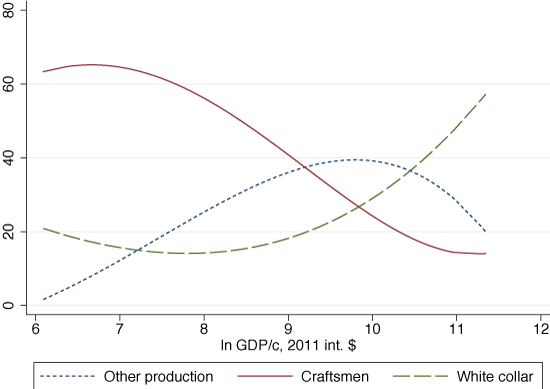
Source: Kunst (2019a).
Notes: The figure shows the predicted manufacturing employment shares from a regression of occupational employment shares among the wage-employed in manufacturing on a third-order polynomial of ln GDP per capita, decade fixed effects and country fixed effects. While the three occupation groups cover almost all manufacturing employees, I do not impose that the fitted employment shares in the three groups in this Figure always add up to 100. See Kunst (2019a) for additional details.
Craftsmen arguably were also the most skilled production workers. For detailed data on relative wages as a proxy for total human capital, I use the extended Occupational Wages around the World database by Freeman and Oostendorp (2019). Figure 2 summarises the wage premia of manufacturing occupations in the 1950s. Handicraft was well remunerated at that time. The typical craftsman earned a wage 16 percentage points above the manufacturing average, whereas the typical other production worker earned a wage 14 percentage points below average. While craftsmen tended to have levels of formal education comparable to other production workers (Kunst 2019a), their substantial wage premium points to higher human capital, acquired for instance through informal apprenticeships and learning on the job rather than formal education.
Figure 2 Occupational wage premia in manufacturing in the 1950s in 112 countries
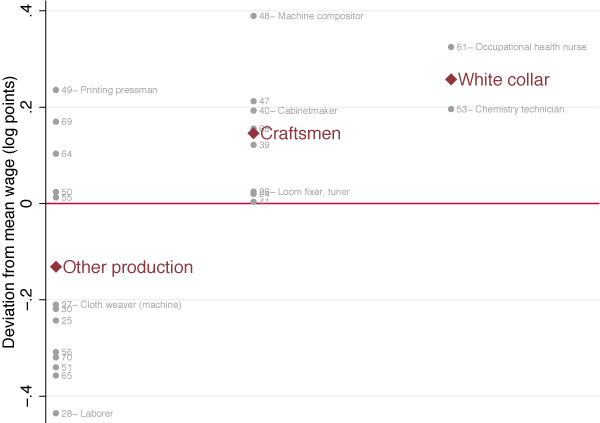
Source: Kunst (2019a).
Notes: The red diamonds represent the occupation group fixed effects from a regression of log wages on country-year fixed effects and occupation group fixed effects. The dots in light grey are the corresponding coefficients from a regression on the more detailed occupation dummies. See Kunst (2019a) for a full list of these occupations.
The Changing Fortunes of Craftsmen
In the literature, deskilling processes have so far been documented for particular countries and industries. For instance, Rasiah (1993) describes how the adoption of shuttleless air-jet looms in the Malaysian textile industry during the 1980s reduced the demand for some skilled craftsmen. Wallace and Kalleberg (1982) argue that the introduction of teletypesetting technology reduced the demand for skilled compositors in the US over the 1931-1978 period. Figure 3 suggests that these case studies capture parts of a global trend. In a sample with relative wages from the textile industries of 133 countries, the left panel shows that the wages of the craftsman occupation of loom fixers and tuners, relative to the machine-operating cloth weavers on average declined by about 4 percentage points per decade between 1953 and 2008. The right panel shows that the wages of machine compositors relative to printing pressmen in the printing industry declined at a similar rate in a sample of 156 countries.5
Figure 3 Craftsman wage premia: Examples from the textiles and printing industries
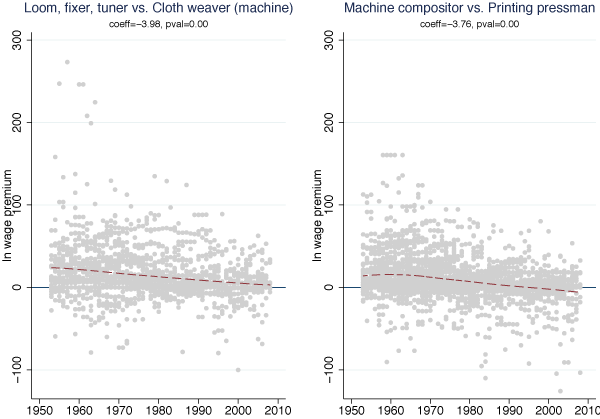
Source: Kunst (2019a).
Notes: The wage premium of loom fixers, tuners (a craftsman occupation) over cloth weavers (machine) (a machine operator occupation) in the textiles industry could be calculated for 1,798 country-year observation from 133 countries in the Occupational Wages around the World database, and the wage premium of machine compositors (a craftsman occupation) over printing pressmen (a machine operator occupation) in the printing industry could be calculated for 2,615 country-year observations from 156 countries. The sub-header shows the point estimate and p-value of a regression of the wage premium on a linear trend (year/10) and country fixed effects, with standard errors clustered at the country level.
One may wonder whether the declining craftsman wage premium is specific to the textile and printing industry, or the selected occupations. In Figure 4, I hence plot the evolution of the average craftsman wage premium for a balanced sample of 86 countries, calculated based on all eight craftsman and 13 other production occupations that are available in the Occupational Wages around the World database since 1953. The figure also shows a substantial decline of the average craftsmen wage premium, from about 37 percentage points in the 1950s to about 9 percentage points in the 2000s, and hence of a similar magnitude as for the examples in Figure 3. The dotted lines show that craftsman wage premia declined in countries of all income levels.
Figure 4 Average craftsman wage premium relative to other production workers
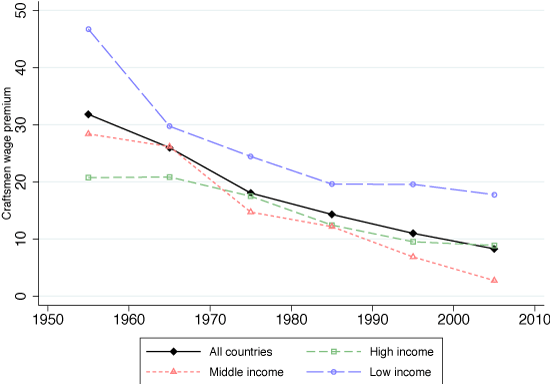
Source: Kunst (2019a).
Notes: The average wage premium of manufacturing craftsmen versus other production occupations is based on 86 countries, of which 19 are classified as high income, 43 as middle income, and 24 as low income.
A testable implication of a demand shift away from craftsmen is a simultaneous decline in their relative employment. Figure 5 compares the number of craftsmen per other production worker in the first available year before 1990 with the last available year after 1990 for 44 countries for which I have employment data for both periods. In the first year (on average 1974), there were on average 4.9 craftsmen per other production worker. In the last year (on average 2009), this number had decreased to 1.4 craftsmen per other production worker in the same countries. While a few countries – such as Paraguay (PRY) or Honduras (HND) – experienced particularly large decreases, the number of craftsman per other production worker decreased in 38 of the 44 countries, consistent with a pervasive demand shift away from craftsmen.6
Figure 5 Craftsmen per other production worker in manufacturing
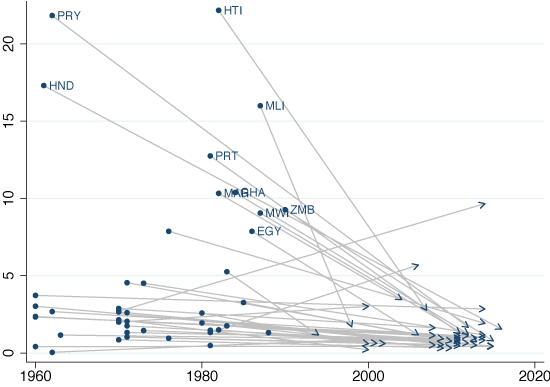
Source: Kunst (2019a).
Notes: The figure assigns country labels to the ten countries experiencing the largest decreases in the number of craftsmen per other production worker.
Discussion
I argue that the declining demand for craftsmen can be understood through the lens of a task model in which a declining price of capital leads to a substitution of craftsman tasks with capital. Consistent with this model, I find that changes in relative craftsman wages and employment within countries over time are significantly associated with changes in manufacturing capital intensities. Task frameworks also highlight that, next to displacing workers, automation may create new tasks (Acemoglu and Restrepo 2019). However, I find that, while craftsman wages decreased relative to occupations outside manufacturing, other production wages did not increase. This suggests that other production workers did not acquire skills comparable to those that craftsmen traditionally possessed, and that any new skill-intensive tasks created by automation have tended to be tasks for white collar workers.
My findings also point to a remarkable continuity in the automation of craftsman tasks in manufacturing, first documented in a literature on deskilling in US manufacturing during the 19th century.7 At the same time, recent case studies from China highlight that deskilling remains a possible outcome of workplace automation even today – in particular in developing countries, where the remaining scope for automation is larger (Huang and Sharif 2017, 2019). Moreover, the accelerating pace of change in labour markets around the world in recent years suggests that the phenomenon of human capital investments losing their market value is increasingly relevant also beyond manufacturing.
These findings do not imply that workers should abstain from making specific human capital investments. Rather, they highlight that, in a technologically dynamic environment, such investments are inherently risky. Hence, social safety nets and subsidised (re-)training programmes have important insurance features which may incentivise workers to undertake such investments in the first place. Strengthening them should be part of the efforts to share the benefits of technological progress widely.
See original post for references


This is certainly confirmation of a process that had its major impetus during the Great Depression. The demands of WW2 and its aftermath, when rebuilding Europe and Japan, building NATO and taking what we could from the British Empire, were paramount, gave us huge advantage in using an already outdated industrial machinery. As Europe and Japan rebuilt with the most modern technologies in steel, transportation, and communications, that advantage was lost.
Coupled with the fears within corporate hallways of the growing labor movement and the strike wave after WW2, the deskilling and breakup of working-class communities into suburban enclaves demanding cars instead of public transport, hopes of petty bourgeois life instead of previously lived culture, created huge inefficiencies within capital that could not be overcome except by automation and reducing employment burdens created by labor contracts.
Our “modernization” was accompanied by closures, movement of industry away from urban centers, and the elimination of worker control over worklife and their knowledge, all taken by corporate mangement, to be doled out on their command. Each industry developed their own skills, not transferable to other comanies or trades.
Mission accomplished.
See Harry Braverman’s “Labor and Monoploy Capital,” on this topic, deep insight from a metal trades worker and scholar.
Seconded. One of the best econ books no one has ever heard of. The man spent, iirc, some decades (or at least years) actually working on an assembly line before becoming an academic. The difference in perspective from your normal economists shows. Glad to see his work referenced here. He doesn’t get nearly the love he deserves.
I’ve read Braverman three times since it was published, and my first thought when reading the title of this post was, “Harry Braverman” has already been here. And, Braverman is the second reference…Deskilling? I went on a tour of the Koehler factory in Wisconsin last week. Reminded of my time in a heavy chemical plant, which doesn’t exist today except as a SuperFund site. My favorite pastime was cleaning up for the machinist, who could turn a block of stainless steel into anything. Human control of machine tools is a thing of the past. Alas.
Products used to be crafted, now they are assembled.
The quality that used to be the result of handicraft is now the result of the ‘finish’ being built into the components which are assembled by deskilled workers or robots.
My Dad told me years ago that where once the heavy sheet metal used to build cars was pretty rough when it hit the assembly line and had to be prepared for painting, every body panel had to be smoothed and probably filled and sanded prior to priming and painting, which involved a bunch of highly skilled workers.
The final surface of the car was the result of expensive prep work and a relatively thick coat of paint applied by a higher paid craftsman.
Today, because of vastly improved, and automated manufacturing techniques, the smooth finish of an automobile fender is already present on the surface of the now much thinner steel as it comes from the factory, and it’s already primed for painting, which can be done by a robot because the care of a craftsman is no longer required to assure that perfect shiny finish.
Those thin steel body panels are no longer hammered back into shape and repainted to repair accidental damage, they are replaced with new perfect panels that arrive in a box.
(When our business delivers a less-than-perfect body panel, the body shop doesn’t spend any time making it right, they return it and demand a new one.)
We get arguably better shiny things, but a poorer, less skilled working class that also owns less pride in their work.
I think we also lost the collective mindfulness that craftsmanship inevitably required and so produced.
I grew up surrounded by an extended family of craftsmen and women, and often worked in an environment filled with very skilled people who cared deeply, and had great pride about what they did, and how they did it.
Those people also demanded that their children pay attention and take care because the world was a better place if they did.
The opportunity to work in that sort of environment was wide spread, and IMO, resulted in a generally high level of mindfulness in the working class.
From this perspective, it seems strange to see the growth of the ‘mindfulness’ movement aimed at self-improvement as opposed to the being the result of habitual care and attention to detail necessary in ones craft.
I have to add to this topic, that the current craze for teaching everyone to ‘code’ is an empty promise sure to lead to frustration and sorrow because computer programming is essentially a craft requiring care, and attention to detail that is hard to instill in a student if they don’t appreciate it up front.
This is why when Ross Perot started EDS, Electronic Data systems, he recruited programmers from university music programs because musicians understand the necessities of craft, there is a beginning, a middle, and an end, and every single note is in its place.
And good code is elegant.
Programmers used to become programmers by following their passion, capital is now trying to mass produce programmers an so ,like every other place where craftsmen and women have been eradicated to save money, we now have programmers who are clever at cutting-and-pasting, and went into programming in the first place because they heard it was a well paying job.
The problem is, if you aren’t appreciative of craft, you won’t be a good coder so you won’t be able hold onto, or advance in that ‘good’ job even if you can get a foot in the door.
Capitals efforts to save money by systematically excluding labor from the processes and responsibilities of delivering products increases profits but impoverishes the working class, and by extension, all of us in more ways than one.
Now get off my lawn.
American car production ran into some challenges from Japanese manufacturers. One famous story involved Ford, when it owned a chunk of Mazda. Engineers from both companies swapped tips and talked about their systems. The Mazda guys proposed a challenge. Can you take your car apart and reassemble it five times and have everything still fit? They could, and the Ford guys couldn’t.
That was back during the era of the Lexus ball bearing ad, where people could marvel at the smooth fit and other seemingly novel features of a different type of car. The knowledge guys on the line got replaced over time by robots, so more human capital walked and drove out the door.
When Ford saw how Mazda worked they invited this person to help straighten out Ford. There is somewhere a pbs special on this story.
https://anaar.com/blog/w-edwards-demings-14-points-revisited/
Excellent read. However, Volkswagen, not Toyota, is now the worlds largest automaker. (By a small margin.)
I can add structural/civil engineers to the coders’ example.
When I used to interview people to work for us, they would inevitably come along with a CV as long as your hand. I would give them a very simple layout of a 2-3 elements, 2-d structure, with a couple loadings applied, and ask for a sketch drawing of a bending moment diagram.
Out of a hundred or so people, about seven managed. Others run for the door.
Now I look at the proliferation of colleges with underwater basket weaving courses, springing up in our small market town at the edge of London, and I think of the student-economy bubble, or indeed someone else’s quote here recently, “every immigrant is a new consumer and a new bearer of a lifetime debt commitment “.
Water it down so amoebas can study it and call it high education. No wonder thousands die at operating tables, having wrong parts removed out of them.
Great comments here, W4B and others, provides the ‘so what’ for the rather dry stats in the piece.
“Bring me the craftsmen / call out the draftsmen / build me a path from craidle to graive…” (Billy Bragg)
Thank you, one of the best comments I’ve read on these issues.
I wish life today gave us more opportunities to learn and practice crafts and experience the mindfulness that comes with it. I try to do it as a cog in the current economy but it is damn nearly impossible. What a loss…
As a long time craftsman I can tell you that the situation sucks something fierce. As soon as management figured out that they could push the production people around at will, they kinda went nuts on a power trip. It’s interesting that the author recommended social safety nets, but what is that going to do if you have no market? When you have to compete with some guy on the other side of the world for pennies? I think we need to globalise our living expenses, since they’ve globalized everything else already.
My college education was in fine arts, ceramics and glass. My mentor/instructors were renowned artists and craftsmen and women, when my employers heard about my education they laughed it up because they thought it was common knowledge that an arts education was worthless.
I didn’t say a word, but I know that most of my worth to them is built upon that foundation.
My knowledge of computers was based on years of self-directed audio/video production work in the early digital realm before they hired me and I’ve been administering their systems and keeping them safe and productive for 25 years, and it’s all based on the attention to detail I learned by having a craftsman’s education.
You’re right, management is crazy, the situation sucks, but there some of us they haven’t figured out how to replace, and when they do, it will be with more expense, and less quality of service.
You too? Same education and same story here. I remember the first day on my old job — you know, the “all hands meeting” introductions etc. I almost got laughed out of the room when they heard the word “arts”. Four years later, I was the “point man” keeping the production systems running (maintenance).
On the way out the door there, I informed senior management that their critical thinking skills were on a par with single-celled organisms, but I support bacteria anyway because its the only culture some people have.
BA, Liberal Arts, and a fairly unusual career path that followed, including high-end residential painting and running my own photography business.
These days, I code, program (and edit and debug existing programs), build panels, run electric from 24-480 volt, troubleshoot industrial heavy equipment, and help to develop and implement automation/systems integration projects.
“Gold collar” is working for me, and I’ve found that the formal education that I received is as relevant to what it is that I do as any technical and vocational training that I’ve had.
AA Fine arts with a lot of Philosophy and Lit thrown in. 30 years of industrial maintenance, welding, fabrication, machining, blacksmithing, chemical plant piping, boiler rebuilding, and some analog electronics…. basically hot, dirty, and thankless. And broke; after 30 years i finally got up to $15/hr (nonunion)
Buddha, I’m sorry to hear that, but not surprised. I’m in a region with a strong union presence, and that makes a huge difference.
Gresham’s Law applies to people.
Best people began leaving manufacturing in early 1970’s when Japan invaded.
Same thing happened in south and cities.
The more competition increases, the more selective companies get and
the more people move to follow the money is.
FED’s tried to make moving easier but again only the best moved.
In the late 1950’s a friend got out of the service and after a few years
moved to Michigan for an unionized automotive job.
We provide a good though not efficient safety net Politics!
Want better people, pay more.
Germany provides very expensive and time consuming training
and pay high hourly wages but then cut hours to so total wage not too high.
A consultant recently told my bosses that if they continued to pay McDonalds level pay, they would get McDonalds type employees.
We were trying to build a new dept. that would require a quality team of new hires.
I’m still not sure they’ve really absorbed that lesson yet.
They seem to rely on even smart resourceful people being desperate for a job.
Maybe you should ask them if they’re willing to train from scratch. Every technical job I’ve ever had, they say that they are training you, to justify the low pay. Even if you already mastered the subject decades ago, at your own time and expense, they will discount that and say they are training you.
Deskilling among production workers sounds like a great business strategy. McDonalds alone has spent three generations trying to remove every ounce of skilling in their workplaces as possible. But what happens when you suddenly find that you need skilled workers again? You can’t buy them. You can’t order them. Skilled workers have to be nurtured and grown over years of effort. Trump can talk all he wants about bringing jobs back to America but the skills required to do those jobs are mostly gone. The people that knew how to do those jobs are either dead or retired. They were thrown on the scrap heap. Even now, business that try to get skilled workers (from what I read) are demanding that these same workers accept minimum wages instead of the professional wages that their trades demand. Watt4Bob’s comment above seems to confirm this happening. Not going to end well this unless there are major changes in attitudes.
Ever since they passed NAFTA I’ve been saying that America is going to *lose* WW3, horribly. The skills are almost gone, and you can’t get management to pay for anything anyways. There will be decades of finger-pointing, deflection, recriminations, denialism, etc.
That is a concern.
When a nuclear armed country KNOWS it can not win a long duration conventional war due to lack of home based manufacturing capacity and manufacturing expertise, the temptation to first use nuclear weapons will manifest itself.
This is another problem with outsourcing manufacturing to countries that may become adversaries in the future.
Yes, while the current “professional” Army is skilled (more so than draftees) it is much too small to stop a larger one, without superior equipment. Equipment that is now obviously inferior (F35, slow cruise missiles, fuel gulping armored toys).
Given the Bozo in the White House, climate change should maybe take a backseat to nuclear annihilation.
It would be my observation that de-skilling is the first step towards off-shoring and then eventually outright automation. YMMV
Great article and well informed and informing comments. Thanks.
Automation strives to attain two goals: increased productivity and lowering personnel costs. At some point, automation no longer can increase productivity. However, if an organization can reduce the time it takes to recruit and train human operators involved in production or sales, deskilling can, in many instances, justify increased automation. The human factor that mitigates against deskilling is when production equipment requires relatively higher skill to maintain than to operate.
Thus, since the days of Henry Ford, deskilling is a logical attraction of developing automation that is more reliable. Reliability reduces payroll costs by eliminating both operators and the need for more highly-skilled maintenance personnel.
Deskilling also ensures that society will have to either (a) unwrite the support of obsolete employees and retrain them at tax-payer expense or (b) create laws that require employing organizations to shoulder that burden thereby reducing profit-taking. Currently, the US taxpayer shoulders the burden of deskilling.
Of course de skilling in as old as the industrial revolution, the Luddite movement was about de skilling making hosiery in early 19th century England. To day a major element is computer numerical control of various metal working machines. The big feature is that these machines produce parts to tighter tolerance than human craftspeople running the tools. Take lathes, a lathe without cnc requires one to manipulate controls but this is often not as reproducible as a cnc machine. Look at Simon Winchesters book, ” The Perfectionists” for details, In particular the section comparing Henry royces (The engineer founder of Rolls Royce with Henry Fords approach to car making.Royce trusted craftsman ship Ford trusted strict interoperability with lower skilled workers. (this was in the pre and post WWI period. ) Note tbat for cnc machining high skill is needed to set up the process, while monitoring the machine is a lower skilled job.